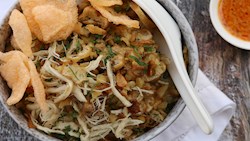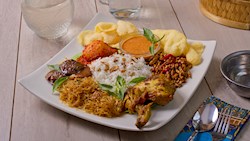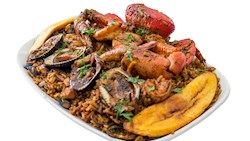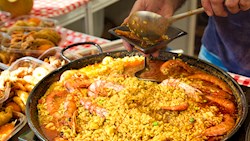Kateh is one of the easiest and simplest techniques for preparing and serving rice, preferably long-grained because it absorbs water better than most other types of rice. The rice is washed, drained, and cooked in lightly salted and oiled water.
It is cooked slowly, over low heat, allowing the rice to absorb all of the liquid. The result is not your typical fluffy rice, but a dish with a dense texture and a clean, undisguised flavor of rice. Kateh is rarely eaten on its own and is mostly served as a side dish.
Since the preparation is not complicated, it is one of the most common side dishes in Iran.
Sushi is Japan's most famous culinary representative, typically made with rice and fillings which have been rolled inside a sheet of dry seaweed. However, the term sushi is actually an umbrella term covering a wide range of subvarieties which can be made with a myriad of different ingredients and in as many forms and presentations.
Although the dish has become wrongly synonymous with raw fish, the primary ingredient of every type of sushi is only vinegared rice. Originally, sushi was only a method of preserving fish - first developed in Southeast Asia, but it reached Japan in the 8th century.
VARIATIONS OF Sushi
MOST ICONIC Sushi
View moreOne of the most popular fresh seafood one-bowl donburi dishes, kaisendon consists of thinly sliced, assorted raw seafood called sashimi laid over freshly steamed rice. What kind of sashimi will be used in a kaisendon dish is not fixed, but the seafood selection depends on both location and season, and most often includes maguro (tuna), tai (sea bream), ama ebi (deep-water shrimps), hotate (scallops), uni (sea urchin), kani (crab), and sometimes even marinated ikura (salmon roe).
Apart from sashimi, kaisendon is typically topped with toasted nori seaweed, myoga ginger, shiso or Japanese basil, cucumber, onions, and either fresh or pickled ginger. Before being placed on a bed of steamy rice, all of the ingredients are drizzled with wasabi-laced soy sauce, and the kaisendon bowl is lastly garnished with some white sesame seeds, white radish sprouts, and wasabi paste.
MOST ICONIC Kaisendon
View moreCharacterized by an incredibly mild and refreshing flavor, negitorodon is a simple Japanese dish which consists of pieces of raw fatty tuna served over rice. Traditionally, tuna used in negitorodon is scraped around the bones or finely sliced, mixed with green onions, seasoned with soy sauce, then placed on a heap of plain steamed rice.
It is easily adjusted with various ingredients and seasonings, and usually comes served with seaweed strips, wasabi, and a raw egg yolk.
MAIN INGREDIENTS
Chutoro nigiri sushi is a traditional type of nigiri sushi. It consists of hand-pressed sushi rice that's topped with slices of medium-fatty cuts of tuna. Different cuts of tuna are classified as otoro (fatty), chutoro (medium-fatty), and akami (red meat).
The dish has a rich and deep flavor and a soft texture. Traditionally, this type of sushi is eaten by hand in a single bite. It's usually accompanied by soy sauce, wasabi, or pickled ginger (gari) on the side.
MOST ICONIC Chutoro nigiri sushi
View moreRisotto alla trevigiana is a traditional dish hailing from Treviso. It's prepared with thinly cut local radicchio, oil, rice, onions, sparkling wine, and stock. The radicchio is sautéed in olive oil with onions, then the rice is added with the wine and stock until the risotto is done.
Before serving, it's usually enriched with a knob of butter and a sprinkle of grated Parmigiano-Reggiano. In the Veneto region, risotto is typically served all'onda, meaning with waves, referring to the fact that it should be slightly more on the thinner, liquid side.
Nigiri or nigirizushi is a special kind of hand-pressed sushi where the meat is sliced and pressed on top of sushi rice. It was developed in Tokyo (then called Edo) during the 1800s. Sometimes, nori seaweed is used to wrap the whole concoction and keep it together.
The topping is usually seafood such as shrimp, tuna, haddock, or eel, and it should always be fresh and of the highest quality. Traditionally, nigirizushi is paired with shiso leaves, wasabi, soy sauce, or pickled ginger. It is sometimes garnished with daikon and salted seaweed.
VARIATIONS OF Nigiri
MOST ICONIC Nigiri
View moreMAIN INGREDIENTS
Makizushi, meaning rolled sushi, is probably the most famous sushi variety. Invented in the 18th century, this type of sushi consists of nori, a sheet of dried seaweed, which is topped with a layer of vinegared rice. A variety of fish, teriyaki chicken, and fresh or cooked vegetables are lined in the middle of the rice, and the combination is then rolled with the help of a flexible bamboo mat.
Finally, the sushi roll is sliced into six to eight pieces, creating a bite-sized delicacy with an intricate and decorative appearance. The whole makizushi group consists of numerous different sushi types such as futomaki, hosomaki, chumaki, uramaki, and temaki.
VARIATIONS OF Maki
MOST ICONIC Maki
View moreHyderabadi biryani is a South Indian dish consisting of basmati rice, goat, mutton, or chicken meat, lemon, yogurt, onions, and saffron. There are two main varieties of the dish – kachchi (raw) and pakki (cooked). It is said that Hyderabadi biryani's richness of flavor is due to the unique process of cooking raw rice and raw meat together with exotic spices, unlike other places where meat and rice are cooked separately.
The special cooking style, known as dum, is believed to have come from Persia during the Mughals' regime in India.
MOST ICONIC Hyderabadi biryani
View moreMaguro nigiri sushi is a traditional type of nigiri sushi. It consists of hand-pressed sushi rice that's topped with slices of tuna. Different cuts of tuna are classified as otoro (fatty), chutoro (medium-fatty), and akami (red meat).
The dish has a mild flavor and a rich texture that makes it great for sushi newcomers. Traditionally, this type of sushi is eaten by hand in a single bite. It's usually accompanied by soy sauce, wasabi, or pickled ginger (gari) on the side.
VARIATIONS OF Maguro nigiri sushi
MOST ICONIC Maguro nigiri sushi
View moreTasteAtlas food rankings are based on the ratings of the TasteAtlas audience, with a series of mechanisms that recognize real users and that ignore bot, nationalist or local patriotic ratings, and give additional value to the ratings of users that the system recognizes as knowledgeable. For the “Top 100 Rice Dishes in the World” list until February 13, 2025, 27,651 ratings were recorded, of which 18,308 were recognized by the system as legitimate. TasteAtlas Rankings should not be seen as the final global conclusion about food. Their purpose is to promote excellent local foods, instill pride in traditional dishes, and arouse curiosity about dishes you haven’t tried.






















































































































